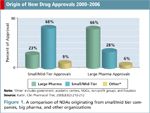New Rules for CROs
Applied Clinical Trials
CROs must adjust their practices to cater to small/mid-tier pharma instead of simply servicing big pharma.
According to data from the Tufts Center for Drug Development, 68% of NDAs came from small/mid-tier pharma between 2000–2006. This compares to an almost equal amount from large pharma at 66%. The takeaway is that it's not just big pharma that CROs have to service anymore; it's the small- and mid-tier company, whose needs, based on its business model, may be different from what the CRO has experienced or planned for in the past.

Figure 1
Applied Clinical Trials spoke to two people responsible for outsourcing decisions at their respective organization: one a virtual pharmaceutical company, the other a small and growing biotechnology company. The business models are different, the end goals are different, but there is one commonality. They don't want to "micromanage" the CRO and they truly want the CRO to bring its drug development expertise to the table.
Celtic Pharma
Category: Virtual Pharma

Executive: Solomon Babani, director, outsourcing and vendor management.
Business Model: A global private equity firm that seeks to acquire direct ownership or controlling stakes in pharmaceutical products and outsources all activities excluding strategic decision making, regulatory interactions, contract negotiations, and project supervision.
Current Goal: Finding CRO(s) for its next equity fund.
Number of Employees: 30
Celtic never plans to market any of its products. It prefers to operate in the Phase IIa, Phase IIb area, looking to purchase promising compounds to which it can add value. Take that compound to the next step and present it for acquisition by a larger pharmaceutical company for further development and marketing stages.
"What sets us apart from the typical company is that we are looking to leverage off of the experience and the expertise found within the CROs that we work with," says Babani. Unfortunately, he has found that many CROs are conditioned to primarily operate within the big pharma model. "They develop this model where big pharma makes all the strategic and hefty brain decisions, and the CROs are merely their arms and legs85essentially saying 'We'll do whatever it is that you want us to, just tell us what it is that you want.'"
For Babani, getting the CRO to think outside the big pharma box has been difficult. "We are looking for expertise and experience, but getting a CRO to think that way and change their mindset has actually been a big challenge," said Babani. "They are used to working in a certain way and their project managers are used to working in a certain way. We find ourselves re-educating our virtual pharma teams, to understand that the CROs we work with are really extensions of the Celtic Pharma team."
The mixture of excitement and frustration is evident in Babani's descriptions. He has worked at Celtic almost two years. He came from big pharma—Novartis and Pfizer, respectively, and before that with biotech company Regeneron. "I wouldn't do anything else," says Babani of the Celtic model. He speaks publicly offering his honest opinions and assessments on this aspect of the outsourcing industry. Most recently, he spoke at IIR's Partnerships with CROs and Clinical Providers conference in April on the topics of "Becoming a CRO Partner of Choice: Preferred Providers and What to Do When You're Not on 'The List'" and "Outsourcing Strategies for Virtual Organizations." He finds that many CROs, who for years said they wanted to work as a true partner to the pharma company, and for years lamented the fact that pharma didn't take advantage of the huge experience and talent it had stabled, is now more than slightly hesitant to grab the brass ring.
"Essentially we want the CRO to manage itself. Our general experience so far is the mid-sized global CRO is much better able to handle what we're looking to do with them," Babani has observed. "It's taken a lot of time and senior management effort on the part of the CROs, and for those who understand it, it's been great." For the second fund, there will be no capabilities presentations from the CROs to senior Celtic management.
The CROs that will work with Celtic will have teams dedicated to the virtual model. This is what Babani wants: Two dedicated people—one with strong operational prowess, and one with strategic strength who can watch over the operations of the CRO. "It is important to have strategic: when things are going on in a study, there is an operational response. But there are things that go on that rise to the level of a strategic issue." Babani related the following example: If many patients in a study miss visits, there's an operational response—call the sites, send out newsletters, incentivize the patients. But at some point, this same issue could have strategic implications. Is this going to impact the outcome of the study? Should we notify the sponsor? Maybe the sponsor will want to enroll more patients or extend the timeline to make sure that endpoint is going to be met.
"If they are noticing something that could have strategic implications, we want them to come to us with a plan in place, with a couple of possibilities moving forward," says Babani. "We want them to tell us their recommendation. This is a totally new way of thinking for the CROs."
NicOx S.A.
Category: Biotech

Executive: Maarten Beekman, MD, vice president, clinical development, and member of the Applied Clinical Trials Editorial Advisory Board.
Business Model: Strategic partnerships, license agreements, collaborative agreements, and research alliances with pharmaceutical companies, including Merck and Pfizer, and specialist companies. It has compounds under development, compounds in co-development, and compounds in R&D.
Current Goal: To be an integrated, specialty pharmaceutical company.
Number of Employees: 120
NicOx is the largest biotech company in France, and is number five in Europe from a market capital standpoint. Its goal is to progress from its research organization roots to a research and development organization, and ultimately to a full-fledged biopharmaceutical company. It recently opened clinical operations in New Jersey, unofficial home to the U.S. pharmaceutical industry.
"I like to keep the clinical group lean and mean. They are an experienced group and that's very important when you are a small pharma and a small biotech," Beekman told Applied Clinical Trials. "They have a lot of knowledge in CRO management, and clinical development. The worst thing I think you can have is a small company with not very experienced people and then outsource to CROs."
Beekman's challenge is to get the same attention from a global, full-service CRO conducting its Phase III trial that big pharma gets. "It is a challenge to ensure the CRO thinks you are an important client because we aren't the Pfizers, the Mercks, or the Lilly's, we are a small biotech company in the south of France. Of course, the program we handle is a big pharma program. But the challenge is do we have the same place on their radar screen as the big pharma?"
What does Beekman expect from its CRO relationship, besides equal footing with other clients? "We write the protocol because we want to do what we think is best for this compound. Then from CRF development up to the clinical study report development, itbeen given to the CRO, including medical monitoring etc., because we don't have enough people to do that," explained Beekman. "We want them to create their monitoring plans, their data management plans, and review them."
These full-service agreements include quality measurements to make sure everyone is on same page. For example, they want to check the quality of regulatory packages. "We'll check the first five and if it's OK, we don't check anymore. If there are problems, then we check the next five," Beekman explains. "The quality measures are there to enable us to feel comfortable that the quality is there and that the expectations are there. But also that we don't spend too many internal resources managing the CRO."
It's a very fine line of managing or not managing the CRO, Beekman admits. He said his team has forbidden him to use the word micromanage¬ ment because of the negative connotation. "Unfortunately, we sometimes have to manage them more closely than we originally wanted," said Beekman.
Even with this, Beekman realizes that there are two underlying issues at play in the relationship: NicOx's attachment and the CRO's time.
"My ultimate goal is that I need less resources to manage the CRO than we are currently using. But we are a small company and this program is our key asset. It's like having a baby and then giving your baby to the babysitter."
Beekman also believes that focus on day-to-day activities can lead to dearth of creativity. "Although the CRO is working well, they may be so busy doing the day to day clinical activities that there is a lack of some creative thinking, such as how to improve recruitment or turn around documentation faster," explained Beekman. "I like people that are proactive and come up with good ideas, but I see that lacking—for good reasons because they are busy. But it would be good, because we are still suggesting the good ideas. It's a pity that we need to keep pushing them for that."
Beekman and his team are in the process of creating preferred provider status with CROs. When Beekman started with NicOx two-and-a-half years ago, he wanted to ensure that the CRO with which it would work had experience in its primary development compound indication, osteoarthritis. He selected a CRO for the whole program, and then had several CROs to mitigate the risk because it was the company's first Phase III candidate and "we didn't want to put all the eggs in one basket." Now the company is ready to pursue the preferred provider route because, as a small company, it eliminates the legal discussions, and the back and forth of contract negotiations.
"As we all know, the margins of the CRO are linked to time and resources, so if you can do the same study with 15 people instead of 30 people, your margins will be higher. We do fixed price contracts. I keep telling the CROs, we spent a lot of time clarifying the expectations and a lot of time going through the contract and this is the cost. If nothing is out of scope then, we expect you to bring it in on time, on budget," explains Beekman. "But if you bring it in earlier, you still get paid for all these people working another month. I've found that lots of CROs are not ready for that. It's a risk they don't want to take."—Lisa Henderson

Improving Relationships and Diversifying the Site Selection Process
April 17th 2025In this episode of the Applied Clinical Trials Podcast, Liz Beatty, co-founder and chief strategy officer, Inato, discusses a number of topics around site engagement including community-based sites, the role of technology in improving site/sponsor relationships, how increased operational costs are impacting the industry, and more.
Behind the Buzz: Why Clinical Research Leaders Flock to SCOPE Summit
February 7th 2025In this episode, we meet with Micah Lieberman, Executive Conference Director for SCOPE Summit (Summit for Clinical Ops Executives) at Cambridge Innovation Institute. We will dive deep into the critical role of collaboration within the clinical research ecosystem. How do we bring together diverse stakeholders—sponsors, CROs, clinical trial tech innovators, suppliers, patients, sites, advocacy organizations, investors, and non-profits—to share best practices in trial design, program planning, innovation, and clinical operations? We’ll explore why it’s vital for thought leaders to step beyond their own organizations and learn from others, exchanging ideas that drive advancements in clinical research. Additionally, we’ll discuss the pivotal role of scientific conferences like SCOPE Summit in fostering these essential connections and collaborations, helping shape the future of clinical trials. Join us as we uncover how collective wisdom and cross-industry partnerships are transforming the landscape of clinical research.
FDA-Approved Gene Therapy Beqvez Shows Sustained Efficacy, Safety in Long-Term Hemophilia B Trial
April 17th 2025Beqvez (fidanacogene elaparvovec), an FDA-approved one-time gene therapy for hemophilia B, demonstrated sustained factor IX expression, low bleeding rates, and a favorable safety profile over long-term follow-up.